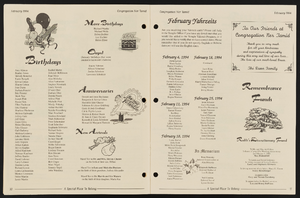Search the Special Collections and Archives Portal
Search Results

Meeting minutes for Consolidated Student Senate, University of Nevada, Las Vegas, April 03, 1979
Date
Archival Collection
Description
Text

Transcript of interview with Sonja Saltman by Barbara Tabach, August 18, 2015
Date
Archival Collection
Description
Included in this oral history are reminiscences of Sonja Saltman's personal non-Jewish heritage in Austria, the importance of her grandmother in her life, and how she recalls becoming part of the Jewish community.
Sonja Saltman is a psychologist and philanthropist in Las Vegas, Nevada. She is executive director and co-founder of the Existential Humanistic Institute, a non-profit organization based in San Francisco, California that offers training in existential-humanistic therapy and theory. In 2003 Sonja and her husband Michael Saltman founded the Saltman Center for Conflict Resolution at the University of Nevada, Las Vegas (UNLV) William S. Boyd School of Law. The Saltman Center is focused on research, teaching, and public service related to "the advanced study of the nature of conflict and how to resolve it." A native of Austria, Sonja Saltman also serves as the Honorary Consul for Austria in Las Vegas. The Saltmans are involved with multiple charitable organizations and initiatives, both locally and abroad. Sonja Saltman has served on the boards of the Anti-Defamation League, Nevada Women's Philanthropy, and the Black Mountain Institute. Projects that the couple has supported include the rebuilding of homes and bridges is Bosnia, and Streetball Hafla, a basketball program to improve relations between Jewish and Arab teenagers in Israel. In 2014 Sonja and Michael Saltman were recognized as Distinguished Nevadans by the Nevada System of Higher Education. Included in this oral history are reminiscences of her personal non-Jewish heritage in Austrian, the importance of her grandmother in her life, and how she recalls becoming part of the Jewish community.
Text
C. D. Baker Photograph Collection
Identifier
Abstract
The C. D. Baker Photograph Collection depicts former Las Vegas, Nevada mayor Charles Duncan "C. D." Baker from 1916 to 1966. The photographs primarily depict Baker at political events, including campaign stops, fundraising events, meetings with officials and politicians, and at important locations in Las Vegas and Nevada. Baker was photographed with politicians such as U.S. Senator Chic Hecht, President Harry S. Truman, Governor Vail Pittman, and Lt. Governor Cliff Jones.
Archival Collection
Las Vegas High School Architectural Drawings
Identifier
Abstract
The Las Vegas High School architectural drawings include blueprints for various improvements, expansions, additions, and renovations performed for the Las Vegas, Nevada high school between 1929 and 1972. The architectural drawing sets include site plans, floor plans, elevations, sections, building component details, and structural drawings.
Archival Collection
Frontier Girl Scouts Records
Identifier
Abstract
The collection consists of records of the Frontier Girl Scouts Council (FGSC) dating from 1944 until 1999. The majority of the collection dates from 1990 to 1999. It contains annual reports and publications of the FGSC, committee minutes and agenda, troop financial records, membership data, and leader training records. It also includes correspondence and publications of the Girl Scouts of the USA (GSUSA).
Archival Collection
J. T. McWilliams Family Papers
Identifier
Abstract
The collection consists of letters, greeting cards, survey maps, newspaper clippings, legal papers, photographs, collected recipes, land sales and expense journals, and survey reference books. The material was created or collected by pioneering Nevada surveyor, engineer, and real estate entrepreneur J. T. (John Thomas) McWilliams and his wife, Iona, between 1900 and 1968.
Archival Collection
John R. Moser Real Estate Appraisal Records
Identifier
Abstract
Collection contains nineteen real estate appraisal reports created by John R. Moser from Las Vegas and rural Southern Nevada (Lincoln and Nye counties) from approximately 1957 to 1972. The reports contain information on the market values of the properties and contextual information explaining the appraisals. This collection also contains photographs and photographic negatives depicting properties, and photographic slides of desert flora and landscapes around Nevada and Idaho such as Groom Mountain Range, White Bird Canyon, Salmon River Valley, Clover Valley, and Ruby Mountains.
Archival Collection
J. A. Tiberti Construction Records
Identifier
Abstract
The J. A. Tiberti Construction Records include material documenting construction work performed throughout Las Vegas, Nevada between 1950 and 2011 including bid packages, specifications, contracts, correspondence, company records, legal documents, and architectural plans.
Archival Collection

